How to Build An eCommerce Sales Funnel Strategy in 2025 [+ Examples]
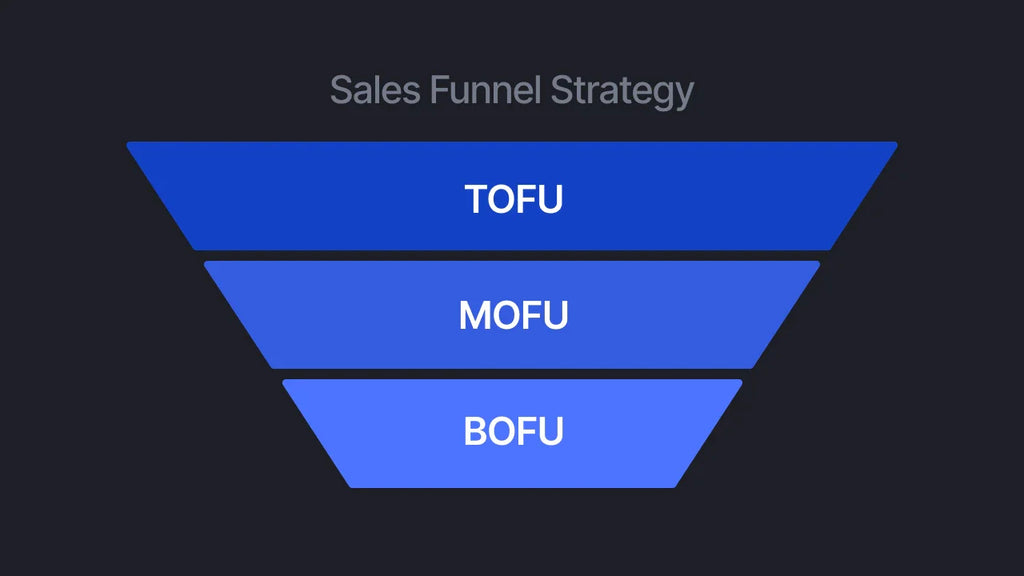
In the past few years, many things have changed in the marketing landscape — but one concept that stood there for nearly 125 years (and still counting) is “the sales funnel strategy”.
In 1898, E. St. Elmo Lewis invented the theory of “the purchase funnel” that maps a customer journey with the AIDA model (where AIDA stands for Awareness, Interest, Desire, and Action).
Over the years, the framework has been redesigned and referred to as “sales funnel”, “marketing funnel”, “conversion funnel”, “customer funnel” and whatnot!
But the core essence remains the same — the conversion of potential customers into paying customers through a journey that goes from awareness to action.
In this blog post, we’ll guide you through the process of building a sales funnel strategy, especially for eCommerce businesses, along with examples to help you enhance your sales and conversions.
What is a Sales Funnel?
A sales funnel is a marketing strategy created to walk customers through a journey—consisting of subsequent stages—from making them aware of your product/service to enticing them to buy it.
What are Sales Funnel Stages in eCommerce?
The subsequent or hierarchical stages of the sales funnel include awareness, interest, evaluation, desire, sale, and then, retention (also referred to as “repurchase” or “loyalty”).
All these hierarchical stages can be mapped at three broader levels in a sales funnel:
How Does a Sales Funnel Strategy Work?
At each of these levels and stages of a sales funnel, you need to offer value and/or engage with customers through various types of digital assets or content, or even services in some cases, e.g., offering a consultation or demo call if you’re selling services.
The below graphical representation of a sales funnel strategy will make it simple and easy to understand how a sales funnel works:
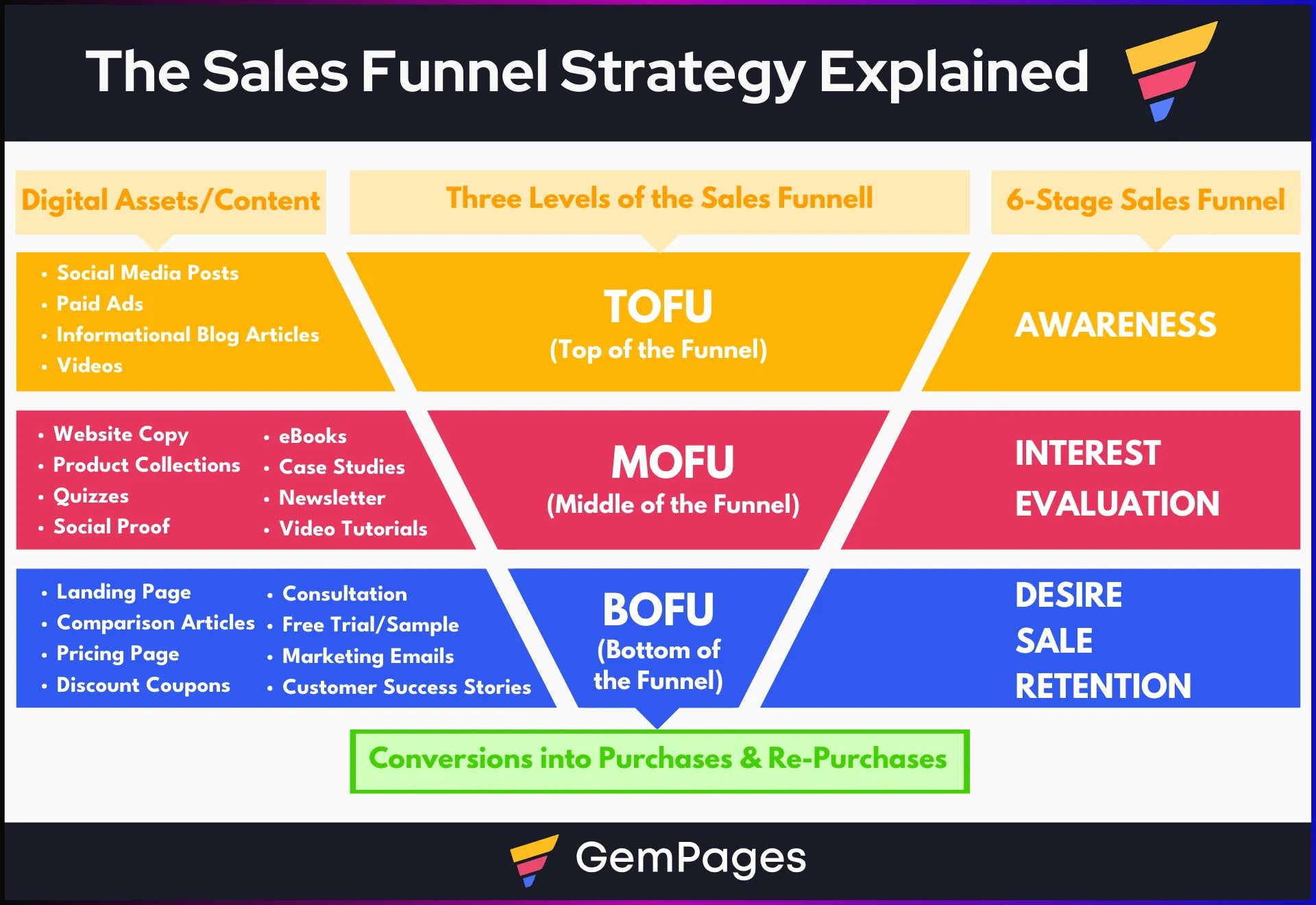
Note: The above example is not meant to be an exhaustive list of all the digital assets and content types that go into a sales funnel but just to give you a basic idea of how things work in a sales funnel.

Understanding the Sales Funnel Strategy and Stages with Examples
Now, let’s go into further detail about each of these levels and stages, and understand them with real examples:
Top of the Funnel (ToFu):
-
Awareness
This is where your sales funnel starts.
At this stage, customers come to know about your brand/product/service. How? Through the following digital channels/assets/content:
- Social Media Posts
- Paid Ads
- Informational Blog Articles
- How-to articles
- Step-by-step guides
- Listicles
- Videos
- Long-form videos like YouTube tutorials
- Short-form videos like Instagram Reels, YouTube Shorts, TikTok, etc.
- Word of Mouth or Referrals
- Search Engines
- E.g., landing on a product collection through Google Search
As you can see, all the digital channels (such as the website, social media profiles, and YouTube) and marketing strategies (such as content marketing, social media marketing, and search engine optimization) play a crucial role here in bringing potential customers into your sales funnel.
Here’s an example of how Gymshark’s blog article that’s ranking in one of the top search results on Google Search when you insert the keyword — “Best Women's Sweatsuits”:
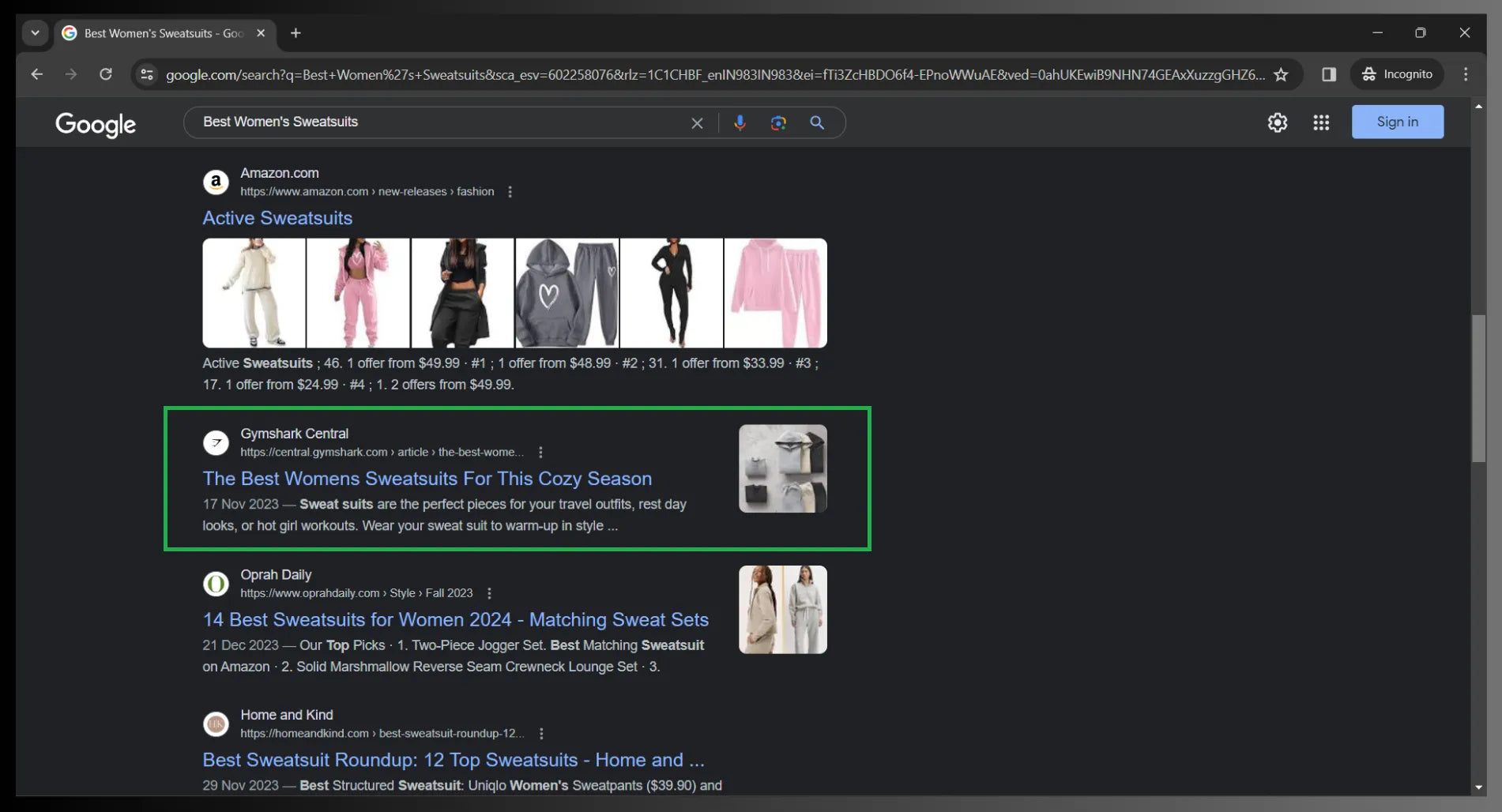
After clicking on the article link, the customer will land on the Gymshark website and explore more about the brand. Thus, it helps Gymshark raise awareness of the brand and its products.
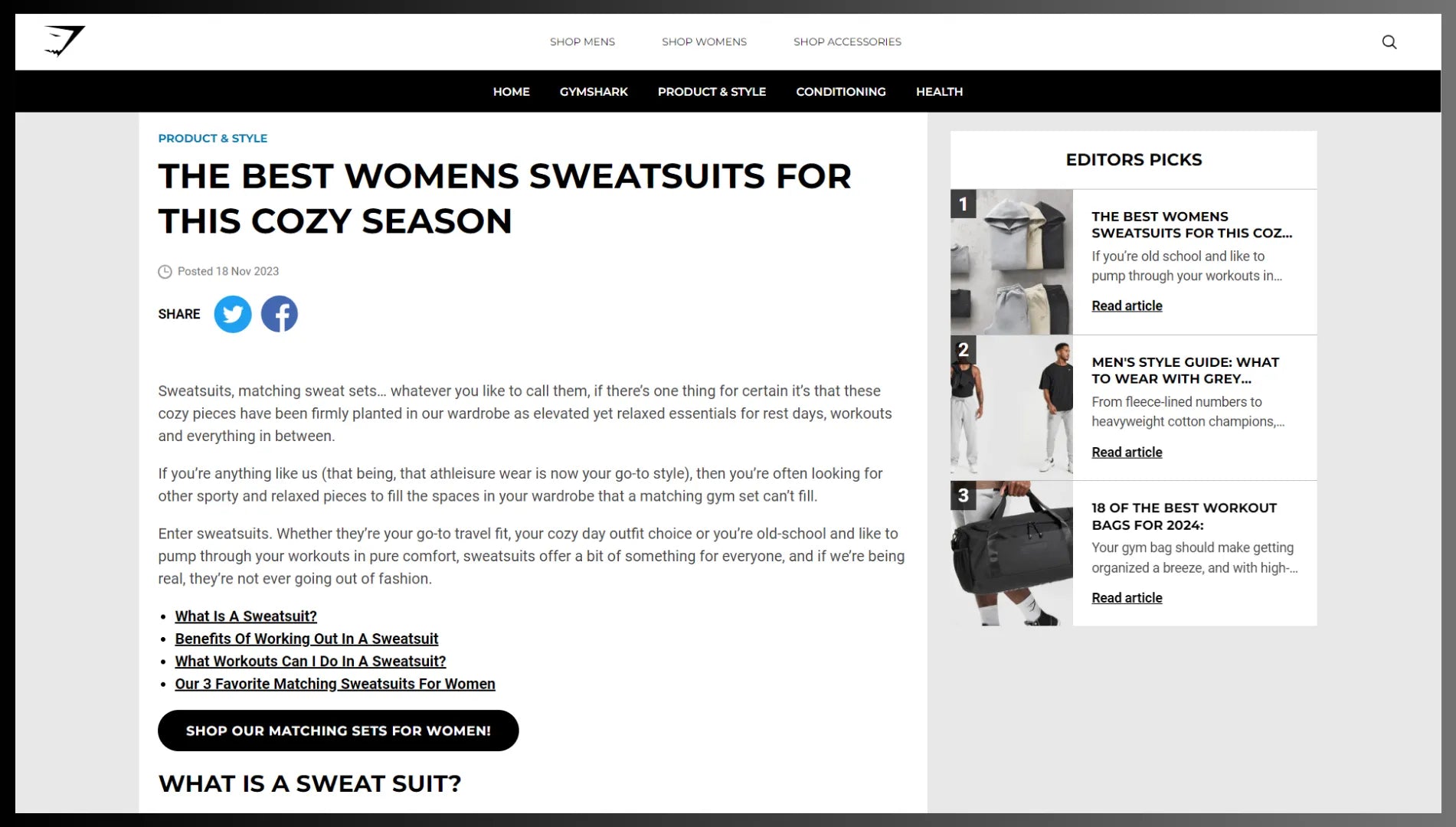
Middle of the Funnel (MoFu):
-
Interest
Once landed on your brand’s website, blog, or landing page — it’s the job of your website copy or content to spark an interest in the customer’s mind.
If your copy or content is compelling and offering value, the customer will gain the initial interest in what you have to offer. But remember — the customer is not ready to purchase your product yet.
Customers may go through or interact with your digital assets in different forms including:
- Website Copy
- Product Collections
- Quizzes
- Social Proof
- Community
For example, Pimax — a brand that manufactures and sells high-end VR headsets and equipment — is a great example of how a brand can use social proof through user reviews.
Also, what’s more interesting is that the brand allows customers to engage with other users through the community too. This is a great way to keep the customers with your brand for a long time and not just during the sales funnel.
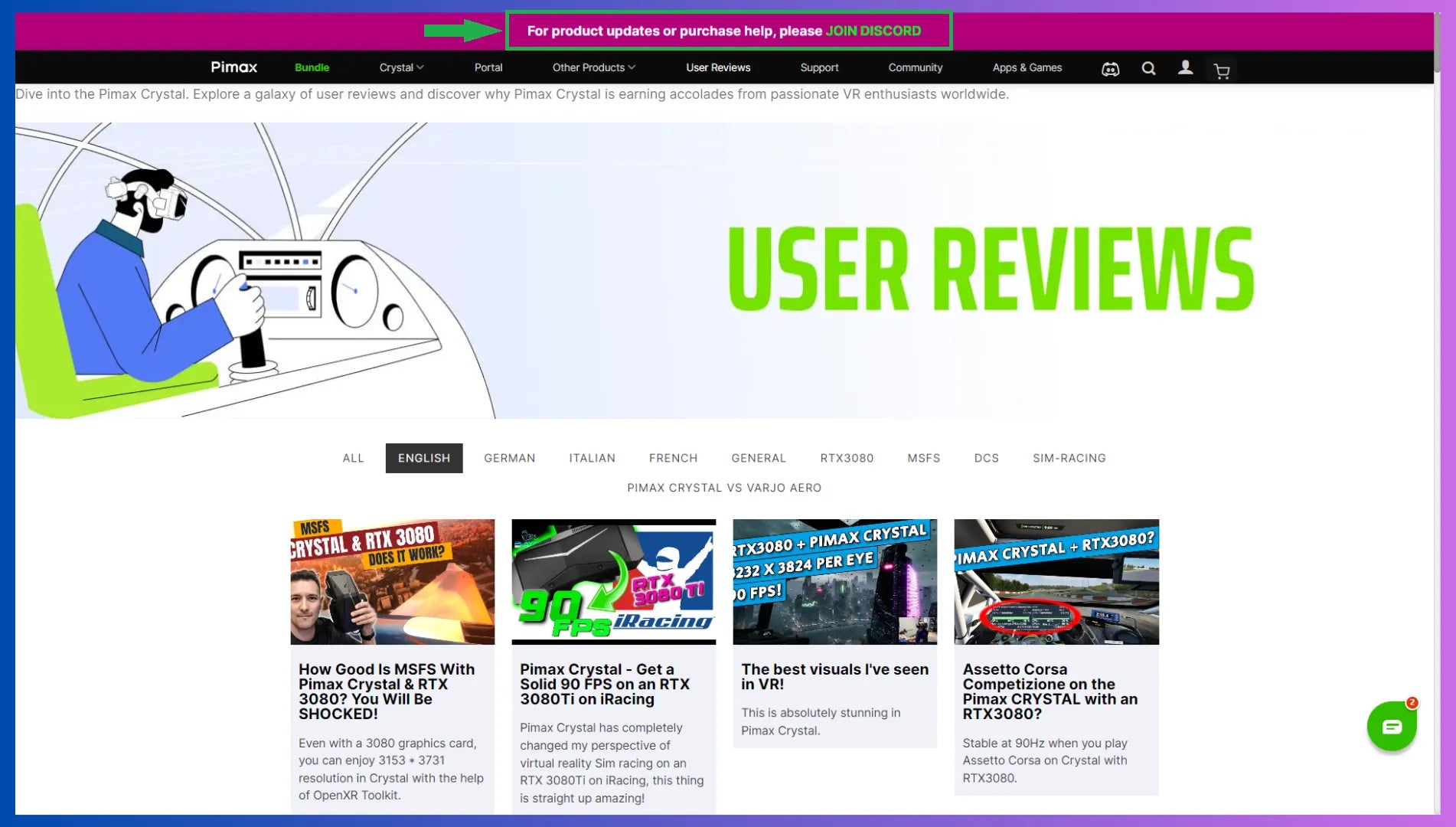
-
Evaluation
This stage may come into the picture mostly when buying expensive products.
When buying expensive products, customers tend to review different alternatives before choosing one. Once you’ve sparked “interest” in the customer’s mind, the customer will consider you in all those alternatives.
Then, the customer dives deeper into “evaluations” and compares the product/service with competitors to see which one’s the best fit.
During this evaluation stage, your content can play a crucial role in converting those potential leads into paying customers. Here are the commonly used content types during the evaluation stage:
- eBooks
- Case Studies
- Newsletter
- Video Tutorials
Let’s take this blog article from Bulletproof as an example. Throughout the article, they’ve nicely placed the product links.
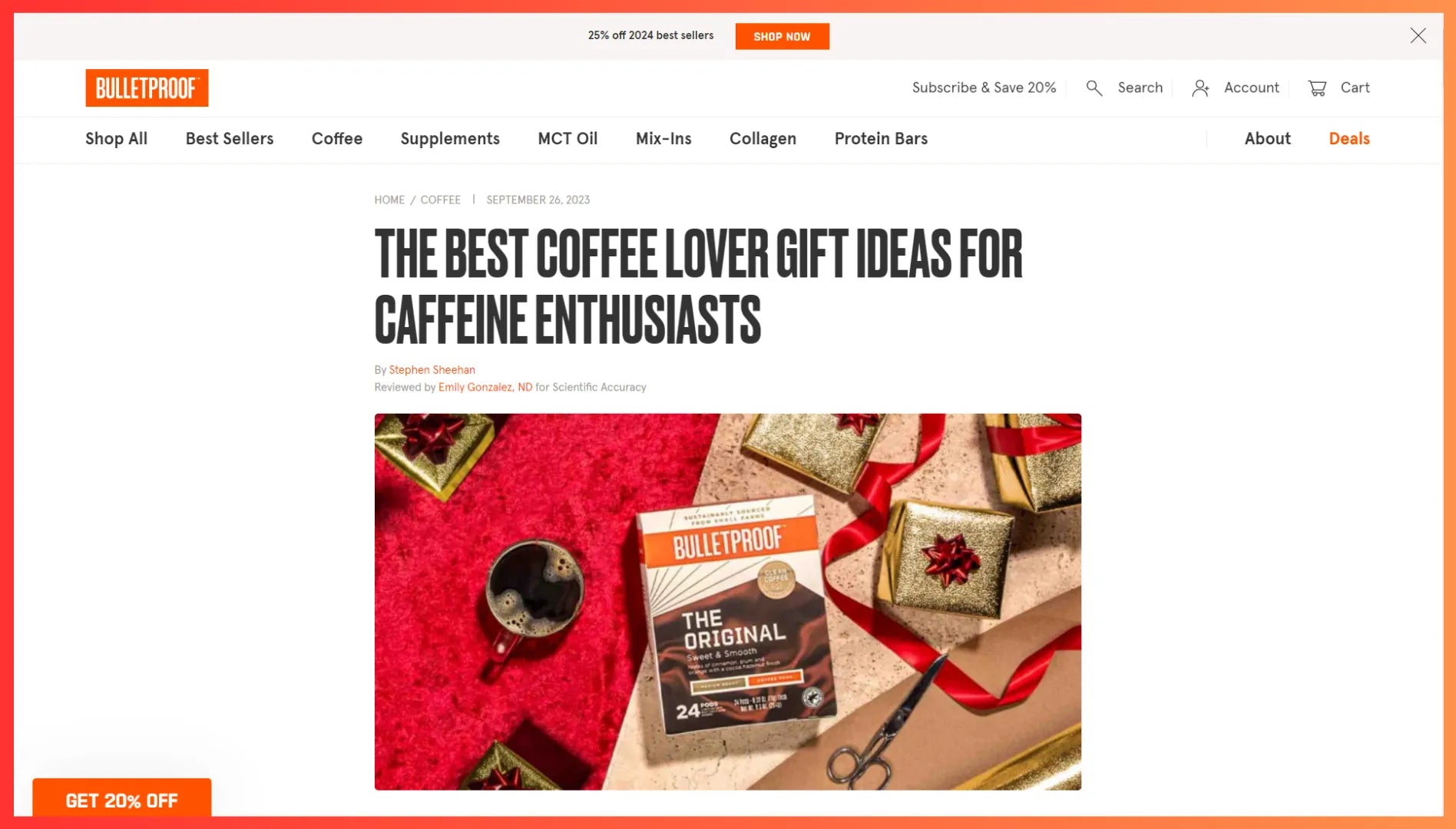
However, some customers may not make an immediate decision to purchase the product. At the end of the article, it has a CTA (Call to Action) to join Bulletproof’s newsletter — which can lead customers further in the sales funnel.
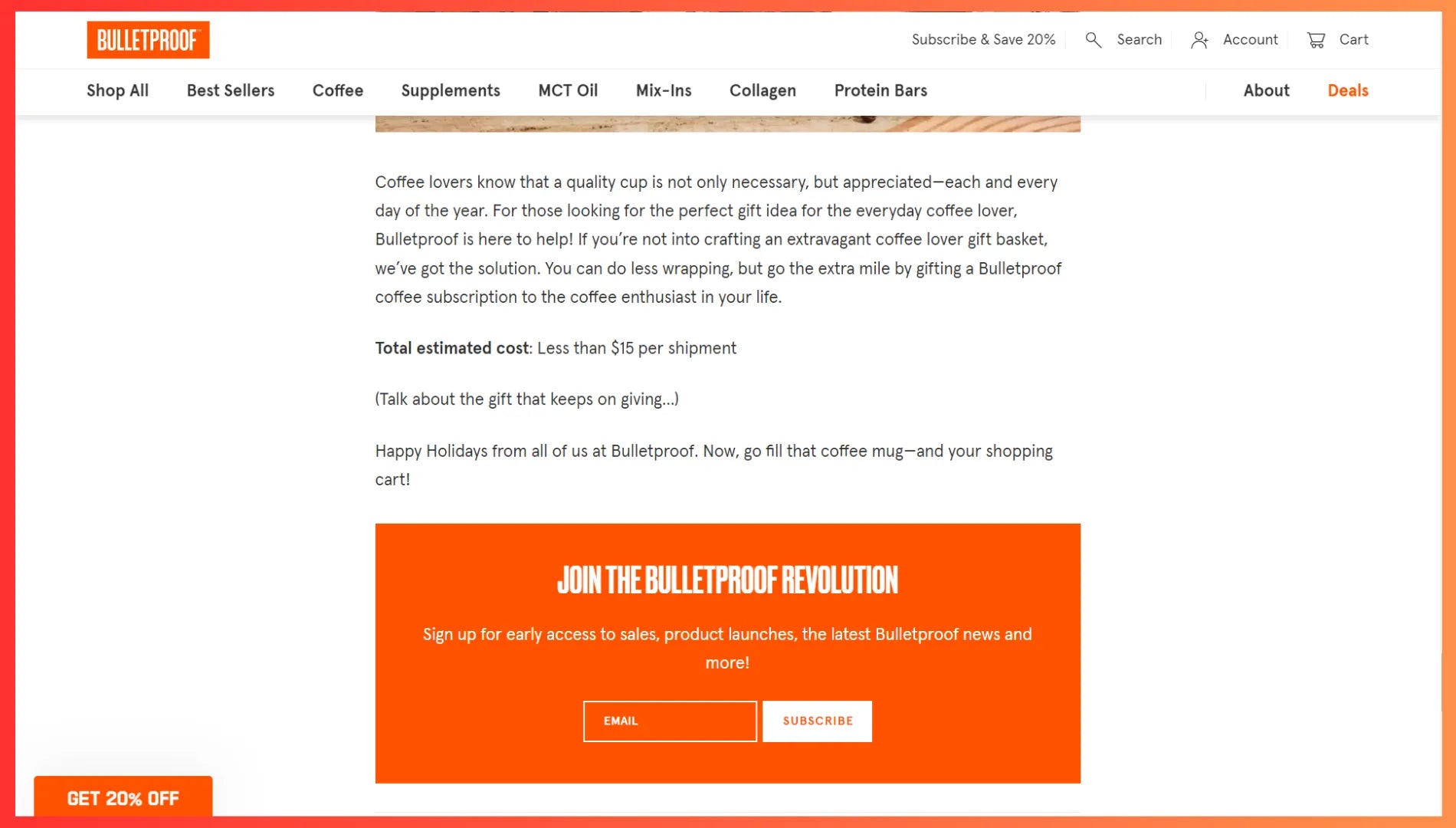
Bottom of the Funnel (BoFu):
-
Desire
This stage is also referred to as a “Decision” or “Intent” stage in different terminologies. Ultimately, it’s the same thing.
After knowing about your product and having done an “evaluation”, if the customer is still under your sales funnel, it indicates the customer has a strong “desire” to purchase your product.
It’s a matter of showing the intent or making that decision to purchase your product. At this stage, the below content types or assets are important in helping the customer make that decision:
- Landing Page
- Comparison Articles
- Pricing Page
- Discount Coupons
- Consultation
- Free Trial/Sample
All these content pieces or pages help customers visualize how the product could benefit them.
Pro tip: At this stage, make sure to highlight your unique selling point (USP). Since the customers have seen all the different options from competitors as well, it may still be in their minds. So, what is it that makes your brand different from others? Address that in your website and landing page copy.
-
Sale
Now, here comes the most crucial stage of the sales funnel.
Throughout the customer journey, from awareness to desire, the customers have seen how your product could be their desired solution, and now they are ready to buy your product.
So, at this stage — the customer will through the checkout, complete the payment, and buy your product/service.
With this stage, the sales funnel achieves its primary goal.
-
Retention
Once the customer has purchased your product, the job is not done yet. You must think of all possible ways to keep the customers coming back to you for more repeat purchases.
During the retention stage, the following strategies could be helpful to bring in those repeat sales and build customer loyalty:
- Marketing Emails
- Community
- Discount Coupons
Side note:
Depending on different business models, there could also be four, five, or six stages in the sales funnel.
As mentioned before, the evaluation stage is typically applicable if you’re selling a high-ticket product. Also, if you’re selling a product that customers typically won’t buy again, you may exclude the retention stage.

How to Build a Sales Funnel Strategy
Now that we’ve learned about all the sales funnel stages, let’s see how to put them into execution and how to create a sales funnel from scratch:
Step 1: Research and Know Your Target Customers
Focus on the fundamentals first!
A sales funnel is basically your customer’s journey, and thus, it’s imperative you know your customers the best as you can. You can achieve this mainly with two different methods:
-
Use existing data and tracking:
- Gather and analyze data from Google Analytics 4
- Use tools to analyze how visitors interact with your website, e.g., Heatmap or Hotjar
- Analyze reports and analytics from your eCommerce platform
-
Actively ask your customers:
- Post questions on social media
- Conduct customer surveys
- Interview your customers or potential customers
- Set up a feedback form on your website
Step 2: Prepare Your Channels to Bring Potential Customers
The very first stage of the sales funnel is about raising “awareness” about your brand and product/service. For that, you need to bring traffic to your website or landing page.
Create ToFu content pieces such as how-to blog articles, social media posts, infographics, checklists, videos, etc. All these content pieces will not only help you bring traffic to your website but also attract them to explore more about your brand.
Most importantly, it’ll help them move to the next stage of the funnel.
Step 3: Create a Striking Landing Page
When you’re publishing your social media posts or ads during the “awareness” stage, you may link them to either your website’s homepage, product/collection page, or landing page.
While all of these options could work, creating a dedicated landing page helps you keep a conversion-focused approach.
What’s a landing page?
A landing page is a standalone web page specifically created for marketing or advertising campaigns. It focuses on the conversion goal by highlighting the key benefits and features of your product—and guides visitors to a specific CTA.
But how do you create a landing page? Well, if you’re planning to start a Shopify store or already running one, GemPages can help you create highly professional landing pages to make your funnel more robust and effective.
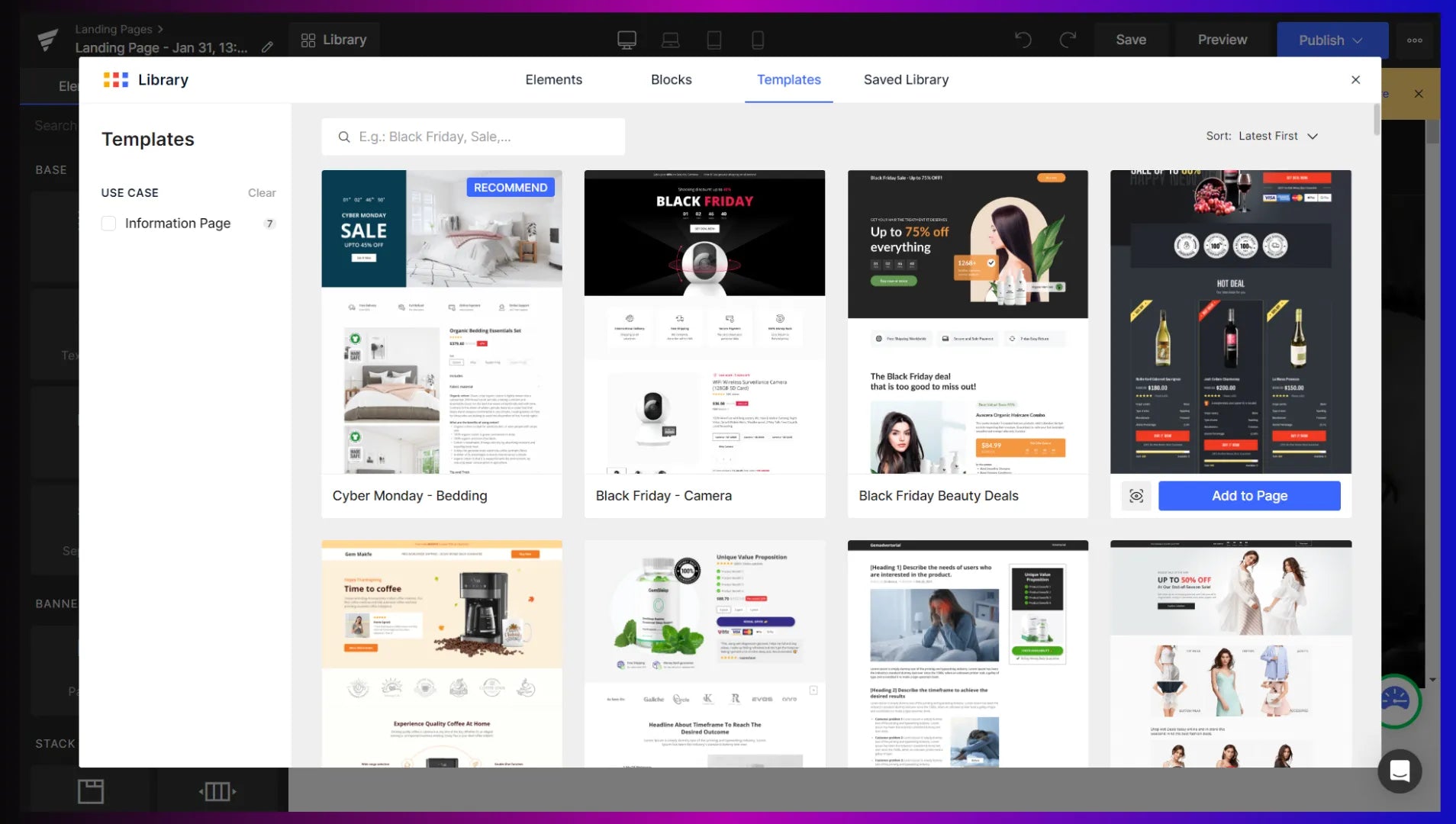
This will not only help you create “interest” in your potential customers but also help evoke “desire” in your customers' minds.
How to Create A Striking Landing Page on Shopify
Step 4: Convert Visitors into Leads
Visitors may come and go, but if you capture their contact information (email addresses and/or phone numbers), they become your leads (potential customers).
It gives you the opportunity to keep them within your sales funnel and guide them through further stages.
But why would they give you their contact information? For that, you need to provide them with some value or incentive. Create a freebie or offer any other reward that customers can avail in exchange for their email/phone number.
Most customers may not be willing to share their phone numbers. In one of the recent surveys, over 68% of US consumers stated they prefer brands to reach out to them via email, whereas only about 34% prefer social media.
There are multiple ways to offer a freebie or reward to your customers and they’ll happily give you their email address. For example, you can create a free eBook providing high-quality content, offer a free gift card redeemable at your store, or provide a free trial or sample.

Step 5: Implement Lead Nurturing Strategies
Once you’ve started generating leads from your sales funnel, it’s time to nurture the leads by keeping them engaged with your content.
The main purpose of lead nurturing strategies is to create the “desire” in your leads to purchase your product and convert those leads into paying customers.
One of the best lead nurturing strategies is to engage with your customers through email marketing campaigns. Apart from email marketing, you can also nurture your leads through an online community, social media, and other free digital products.
Learn more: Lead Capturing Landing Page: How to Create
Step 6: Close the Sale with an Irresistible Offer
The most engaged leads in your sales funnel will reach the bottom of the funnel.
Once again, a landing page can play a crucial role here. Now that the customer is ready to buy your product/service, you can close the deal with a landing page that presents your best offer.
Make sure to give your customers everything they need to complete that final step and make the payment. You don’t want your leads to exit the funnel due to any weak points in your funnel.
For example, an FAQ page, trust badges, preferred payment options, and a smooth checkout experience ensure your customers easily go through this stage.
Step 7: Don’t Miss Out on Repeat Sales Opportunities
Once the customer completes the purchase, encourage them to purchase repeatedly from your brand. For example, you can create a loyalty program for your Shopify store, and when customers purchase anything, they get reward points.
Similarly, you can also offer discount coupons, gift cards, or any other type of enticing offer for future purchases.
Most importantly, build a community of loyal customers through delivering quality products and offering great customer support.
Step 8: Evaluate and Enhance Your Sales Funnel
Regularly monitor your sales funnel and analyze the sales and conversion data.
If you don’t see the desired results through your sales funnel, identify the potential areas of improvement and fix them.
For example, if you’re running email marketing campaigns but there are not many sales coming through those campaigns, check out the average open rate and average click rate of your email campaigns.

Benefits of Sales Funnel
-
Increases Your Sales and Revenue
Your website may be visited by thousands of users, but what’s the point if those visitors exit the website without any purchase? The primary goal of a sales funnel is to make sure those potential customers are converted into paying customers.
With a systematic and strategic approach, a sales funnel creates a solid foundation to achieve this goal, and as a result, your business can increase sales and revenue.
Learn more: Unlocking the Potential: Boosting eCommerce Average Order Value
-
Enhances the Customer Experience
Designing a sales funnel—with well-structured content—guides customers throughout their purchase journey. It not only provides value to the customers but also helps them make the buying decision.
Thus, overall, a sales funnel can help you improve the customer experience and provide them with a smooth and personalized experience.
-
Optimizes Your Lead Management
Since you can monitor a sales funnel throughout the customer journey, you can identify and manage the leads at each stage.
For example, when you’re able to bifurcate your leads into different categories such as Marketing Qualified Leads (MQL) and Sales Qualified Leads (SQL), you can segment your marketing campaigns accordingly.
-
Build a Strong Connection with Your Customers
A sales funnel aims at engaging with customers and providing value at multiple touchpoints. Throughout the customer journey, customers stay connected with your brand, and it allows you to build a relationship with your customers.
For example, when customers sign up for a newsletter through your sales funnel, you can tell them your brand story (and don’t just send out promotional emails). It helps create a strong bond between your brand and your customers.
-
Implement Automation in the Sales Process
There are certain steps that you can automate and still maintain a robust sales process. For example, you can create an entire automated flow starting from publishing the social media post to offering a lead magnet to running email marketing campaigns.
Create Your Sales Funnel Strategy Now!
Building a solid sales funnel strategy may require you to invest time and money. But ultimately, it’s worth putting in your time and resources as you’ll earn a return on your investment.
Make sure you have all the sales funnel builder tools and software in your tech stack to create the funnel that can actually generate results.
Additionally, here’s a step-by-step guide to building an effective click funnel and you can also check out the guide to creating an eCommerce website conversion funnel.
As always, GemPages loves helping entrepreneurs create high-converting landing pages and achieve their conversion goals through funnels. Also, don’t forget to join the GemPages Facebook community to learn from real experts and entrepreneurs.




 Facebook Community
Facebook Community Change Log
Change Log Help Center
Help Center






![How to Build a High-Converting Facebook Ads Funnel [2025]](http://gempages.net/cdn/shop/articles/Facebook_Ads_Funnel-thumb_7a583f1a-80ec-4b88-bdd8-3724e5fb0740_480x480.webp?v=1764509321)




